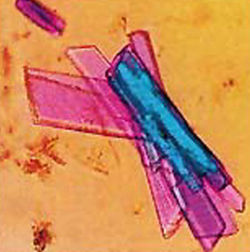- CKMB
-
Creatin-Kinase Kristalle unter dem Mikroskop Vorhandene Strukturdaten: 1QH4 Größe 380 Aminosäuren Struktur Homodimer, Heterodimer Isoformen BB, MB, MM Bezeichner Gen-Namen CKB, CKM Externe IDs OMIM: 123280 UniProt: P12277 Enzymklassifikation EC, Kategorie 2.7.3.2 Kinase Reaktionsart Phosphorylierung Substrat Kreatin Produkte Phosphokreatin Vorkommen Homologie-Familie Guanidokinase Übergeordnetes Taxon Lebewesen Die Creatin-Kinase (CK, EC 2.7.3.2, auch als Creatin-Phosphokinase, CPK oder als Kreatinkinase bezeichnet; man stößt auch sehr häufig auf die falsche Bezeichnung Kreatinin-Kinase - (Kreatinin ist die Ausscheidungsform des Kreatins) ist ein Enzym, das eine N-Phosphoryl-Gruppe von Phospho-Kreatin auf ADP überträgt. Mit dieser enzymatischen Reaktion wird Adenosintriphosphat [ATP], die universelle Energiequelle in allen Zellen, regeneriert. Das Enzym findet man in allen Muskelzellen und im Gehirn. Es werden vier Isoenzyme, CK-MM (Skelettmuskeltyp), CK-MB (Myokardtyp), CK-BB (Gehirntyp) und CK-MiMi (Mitochondrientyp), unterschieden. Die Gesamt-CK ist die Summe dieser vier Isoenzyme. Weil die Gesamt-CK meist NAC-stabilisiert gemessen wird, wird für Angaben der Gesamt-CK-Aktivität oft die Abkürzung CK-NAC verwendet.
Die CK ist ein wichtiges Enzym für die Diagnose von Schädigungen der Herz- und Skelettmuskulatur, die mit einem Anstieg der CK einhergehen. Die Höhe eines CK-Anstiegs und die Infarktgröße korrelieren miteinander. Da man aus der Aktivität der CK schwer zwischen Herz- und anderen Muskelzerstörungen unterscheiden kann, wird immer häufiger das Troponin zur Herzinfarktdiagnostik benutzt. Ist der Wert der CK-MB größer als 6 % der Gesamt-CK, geht man von einem Myocardschaden aus. Bevor die Möglichkeit zur Bestimmung des Troponins bestand, galt eine CK-MB-Erhöhung > 10 % zusammen mit einem charakteristischen EKG-Befund oder charakteristischen Beschwerden als sicherer Infarktnachweis.
Inhaltsverzeichnis
Labordiagnostik
In der Labordiagnostik wird die CK-Aktivität aus dem Plasma oder dem Serum bei Verdacht auf Herz- oder Skelettmuskelerkrankungen bestimmt. Die Messung der CK-Aktivität im Rahmen der Herzinfarktdiagnostik ist heute jedoch nicht mehr notwendig, da bessere Tests wie Troponin T/I oder CK-MB Masse verfügbar sind.
Referenzbereich für Messungen bei 37 °C nach IFCC
- Frauen: <167 U/l,
- Männer: <190 U/l.
Kinder:
- 0d - 1d: < 712 U/l
- 2d - 5d: < 652 U/l
- 6d - 6m: < 295 U/l
- 7m - 11m: < 203 U/l
- 1a - 3a: < 228 U/l
- 4a - 6a: < 149 U/l
- 7a - 12a:
- weibl.: < 154 U/l
- männl.: < 247 U/l
- 13a - 17a:
- weibl.: < 123 U/l
- männl.: < 270 U/l
Eine Erhöhung der CK deutet auf eine Herz- oder Skelettmuskelerkrankung hin, bei der Muskelzellen geschädigt wurden. Bei allgemeinen Muskelerkrankungen, wie der Progressiven Muskeldystrophie oder Myositis, ist die CK-Aktivität auf über 25000 U/l stark erhöht. Bei einem Herzinfarkt liegt die CK-Aktivität meistens unter 7500 U/l. Jedoch können auch Jogging oder intensives Krafttraining bereits einen Anstieg der CK-Aktivität auf 1000 U/l bewirken.
Nach Operationen, Injektionen (i. m.) und Verletzungen, bei denen Muskelzellen betroffen sind, steigt die CK-Aktivität ebenfalls an. Hier ist die Aktivität abhängig von der Größe der Verletzung.
Siehe auch
Literatur
- Neumeister, Besenthal, Liebrich: Klinikleitfaden Labordiagnostik, München/Jena, Urban&Fischer, 2003, ISBN 3-437-22231-7
- Lothar Thomas: Labor und Diagnose, Frankfurt/Main, TH-Books, 2005, ISBN 3-980-52155-9
- Wallimann T, Wyss M, Brdiczka D, Nicolay K, Eppenberger HM. (1992): Intracellular compartmentation, structure and function of creatine kinase isoenzymes in tissues with high and fluctuating energy demands: the 'phosphocreatine circuit' for cellular energy homeostasis. In: Biochem J. 281:21-40.
- Schlattner U, Tokarska-Schlattner M, Wallimann T. (2006): Mitochondrial creatine kinase in human health and disease. In: Biochim Biophys Acta. 1762(2):164-180.
- Schumann G, Bonora R, Ceriotti F, et al: IFCC primary reference procedures for the measurement of catalytic activity concentrations of enzymes at 37 degrees C. Part 2. Reference procedure for the measurement of catalytic concentration of creatine kinase. In: Clin. Chem. Lab. Med.. 40, Nr. 6, June 2002, S. 635–42. doi:10.1515/CCLM.2002.110. PMID 12211662
Weblinks
Wikimedia Foundation.

